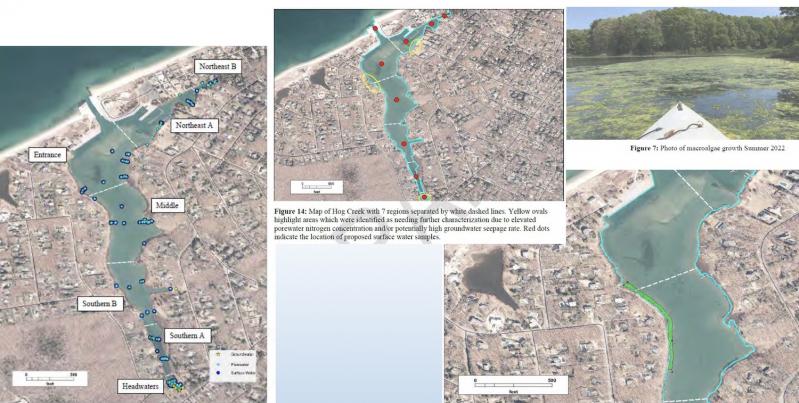East Hampton Town’s Water Quality Technical Advisory Committee on Tuesday recommended that the town fund projects in East Hampton and Sag Harbor Villages, Montauk, and Springs.
Among the eight projects are an expansion of the wastewater management district in Sag Harbor Village, a constructed wetland wastewater treatment system at Most Holy Trinity Catholic Church in East Hampton, and the upgrade of a failing septic system at the East Hampton Historical Society’s Clinton Academy.
In 2016, voters approved a referendum to allow up to 20 percent of community preservation fund proceeds to be used for water quality initiatives each year. The town issues a biannual request for applications to fund projects ranging from wastewater treatment improvement to aquatic habitat restoration and abatement of pollutants from point and nonpoint sources. The committee considers the merits of each and provides recommendations to the town board, which votes on approval of the expenditures.
This week’s recommendations emerged from the committee’s first request for applications in 2023. Applications were due on Feb. 15 for this round, with around $2 million available. The committee reviewed 10 applications, which were ranked on criteria for water quality benefits, cost, maintenance, and monitoring and longevity. Of those, seven were deemed complete and recommended for grant awards totaling roughly $1.76 million. Another was deemed complete and recommended for funding as a town project. Two were deemed ineligible and were not recommended for this round of funding.
Mellissa Winslow, a principal environmental analyst in the town’s Natural Resources Department, told the board that the committee was recommending that Sag Harbor Village be awarded $645,836 for the second phase of an expansion of its wastewater management district to include more residences. Last year, the town awarded the village $288,800 for final engineering design for in-street piping to collect and convey 9,800 gallons of wastewater per day from “sewershed L” to its sewage treatment plant. In the second phase, street-to-residence piping would be installed. This would remove 33 East Hampton Town and seven Southampton Town properties from conventional cesspools, conveying an additional 12,562 gallons per day.
The project would have a significant positive impact on Sag Harbor Bay, Ms. Winslow said, by removing a large number of conventional cesspools and accessing improved treatment at the sewage treatment plant.
The committee recommended a $434,800 grant to Most Holy Trinity Catholic Church in East Hampton for a constructed wetland wastewater treatment system to replace the existing septic system. The constructed wetland system, which Ms. Winslow said has demonstrable nitrogen-reducing capability and potential for widespread use at larger-scale sites like schools, houses of worship, and public meeting areas, would serve the church, its administrative building, and the parish hall. The latter building was added to the project at the committee’s request.
Councilman David Lys said that he is opposed to a constructed wetland, preferring a conventional system that would cost significantly less. “The committee struggled with that, too,” Ms. Winslow said, but after discussions with officials at the Center for Clean Water Technology at Stony Brook University, members “saw the benefits of supporting the technology itself,” she said. “It could be promising for a lot of other problem sites” and “a good demonstration piece. But it’s up to the board.”
The committee recommended a grant of $341,655 to Cornell Cooperative Extension for the next phases of an ammonium plume remediation project through a multi-phase permeable reactive barrier to intercept groundwater flow reaching Accabonac Harbor at the Springs General Store. This would see long-term monitoring and treatment of ammonia using aerated treatment columns that carry contaminated water toward the surface for easier additional treatment. Ammonia is converted to nitrate and can then be treated with a wood chip-based permeable reactive barrier.
The Accabonac Protection Committee and the town funded initial phases of the project, which Ms. Winslow said will have applications to other problem areas where legacy contaminants such as ammonia are entering water bodies.
The committee recommended another $111,843 grant to Cornell Cooperative Extension for the second phase of a multiphase project to reduce groundwater nitrogen input to Hog Creek. The town retained the extension to identify hotspots of nitrogen intrusion. The project calls for three permeable reactive barriers in the hotspot areas — the northeast, western shoreline, and southern headwaters — and nutrient removal through bio-extraction during the summer.
The committee recommended an additional $113,869 grant to the Center for Clean Water Technology for installation of wood-chip biofilter polishing units at eight sites in the town where an innovative/alternative septic system is being, or was previously, installed. The sites are to be chosen based on criteria approved by the committee in priority areas. The purpose is to reduce nitrogen from effluent below what I/A systems are presently capable of. “It’s proven technology,” Ms. Winslow told the board, “but they want to get systems in the ground” to study their performance.
The East Hampton Historical Society would receive a $65,000 grant to replace a failing conventional septic system with an I/A model at Clinton Academy. Similarly, a $42,689 grant was recommended for Ditch Plains Cottages, a five-unit motel in Montauk, to replace a conventional septic system that suffered a “catastrophic failure” with an I/A model.
Finally, the committee recommends that the town fund an I/A septic system replacement at the Montauk Playhouse Community Center to treat 5,216 gallons of flow per day and stormwater abatement infrastructure associated with a proposed new parking lot. The estimated cost is $526,520. The Playhouse is on town property and must follow procurement policies, so the committee recommends that the I/A upgrade portion of the project be funded with C.P.F. water quality money but managed as though it is a town project.
The committee’s second round of its 2023 request for applications opens on June 1, with applications due by Aug. 1. Ms. Winslow said that around $2 million is expected to be available for projects awarded in that round as well.




